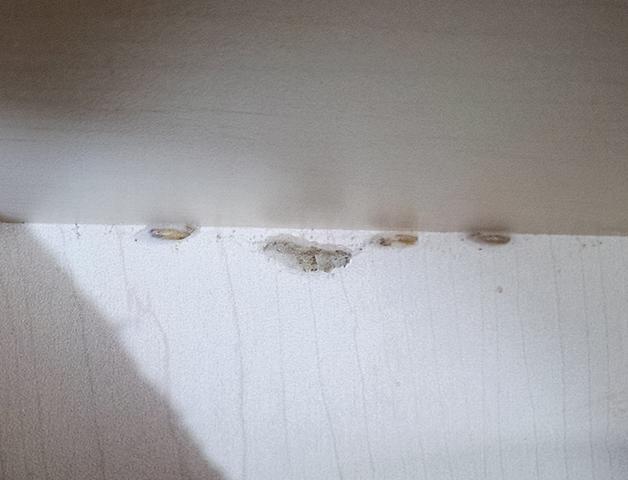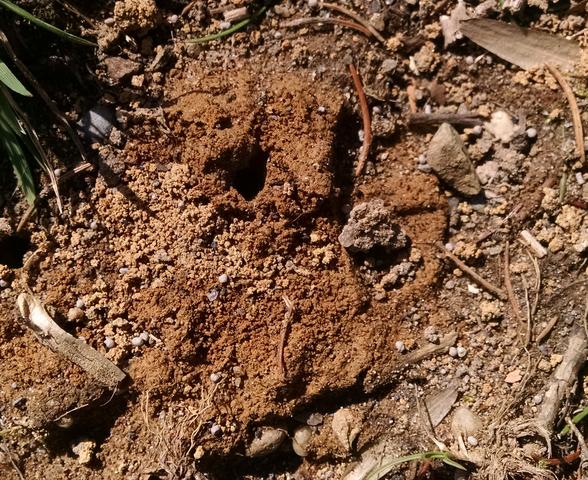Two for one infestation in Holmdel, NJ: Meal moths and digger bees
Challenge
Unfortunately, homeowners are sometimes faced with multiple pest problems. Insects do not know about the one-infestation-at-a time rule. A Holmdel homeowner was faced with both Indian meal moths in the kitchen cabinets and miner bees that were creating holes all over his front lawn.
Indian Meal Moths
Indian meal moths, a type of flour and grain moth, are a major pest in grain mills. They can also do much damage in a home, usually in the kitchen where food is stored. The adult moths are harmless. The problem is the destructive larvae that spin cocoons in food, contaminates it. If you find “white worms” and webbing in any of your foods, they may well be grain moth larvae. The Indian meal moth is the most common of these food-infesting moths. Food infested with these insects will have silk webbing present, especially near the food surface. Home infestations often start when contaminated dried pet foods or birdseed are inadvertently brought into the house. Nuts are also a common breeding source for these pests, and infestations have resulted from infested nut caches of squirrels in attics and chimneys.
We are often asked if you can get sick by inadvertently eating food infested with moth larvae. Admittedly, it is disgusting to be eating insect larvae of any type, and that alone could make you sick. However, since these insects do not contact disease-containing surfaces, they do not transmit disease, and there should be no harm to people or their pets from eating any affected food before realizing that you have an infestation. Even though meal moths infest food, you are not likely to find the adults hovering around there. Moths are phototropic; they naturally gravitate toward light. (There is a scientific basis for the simile “like a moth to a flame.”) Because Indian meal moths are most active at night, you will often find them in rooms away from their food source as they follow the lights turned on in other rooms.
Miner Bees (Digger Bees)
Miner bees, also called digger bees, are solitary bees that nest in soil. They are so-named because they dig tunnels to rear their young. For these bees, it's all about location. Their nesting is restricted to certain sites that they are attracted to because of various land features such as slope, soil type, and drainage. Because of this selectivity when choosing nesting areas, even though they are solitary bees, they appear to live in "colonies" that can number in the hundreds. Miner bees are non-aggressive and rarely sting unless handled or trapped in clothing. Even then, their sting does not come close to that of a yellow jacket. Male bees don't sting at all; their job is to perch nearby in in shrubs, waiting to mate.
In most cases, digger bees are not a problem, and individual bees with their individual nests rarely cause any trouble. If only a few of these bees burrowed into your lawn, you wouldn’t even notice. The problem arises when you have hundreds of these active bees swarming over your property. The fact that these bees are generally harmless compared to other stinging insects is of little consolation when your property becomes pockmarked with little mounds of dirt sticking up all over and every morning you are greeted with a swarm of buzzing bees.
Solution
How we resolved both infestations:
The only way to permanently resolve a meal moth infestation is to to remove all of the infested food products from your home. If you have a meal moth problem, you have infested food that is filled with moth larvae somewhere in the house. While in the home, we helped to expedite the resolution of this moth infestation by using a HEPA vacuum to remove any visible egg casings and larvae.
Resolving a soil-nesting bee infestation can be a challenge. With this Holmdel residence, we sprayed the property with a combination of general pesticide and insect growth regular to prevent multiplication. Finally, a thin layer of dust was applied to the many mining bee holes. Applying a residual insecticide can be slow because you have to contend with sun and rain degrading the chemical, but we’ve done this many times before, and we’ll successfully knock down this population. No matter what, Cowleys will stay on the job until this homeowner gets his property back.

